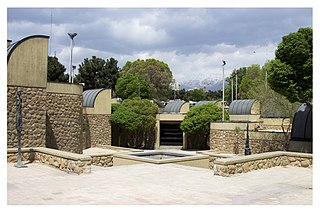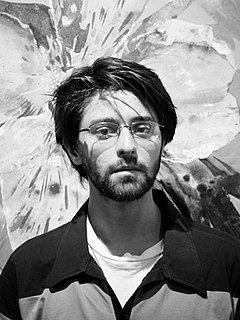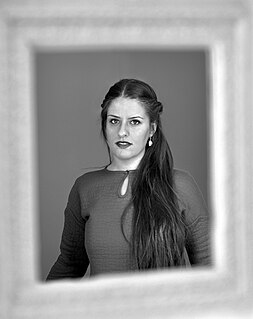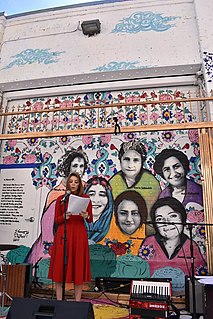Related Research Articles

Tehran Museum of Contemporary Art,, also known as TMoCA, is among the largest art museums in Tehran and Iran. It has collections of more than 3,000 items that include 19th and 20th century's world-class European and American paintings, prints, drawings and sculptures. TMoCA also has one of the greatest collections of Iranian modern and contemporary art.

Shirin Neshat is an Iranian visual artist who lives in New York City, known primarily for her work in film, video and photography. Her artwork centers on the contrasts between Islam and the West, femininity and masculinity, public life and private life, antiquity and modernity, and bridging the spaces between these subjects.

Amirali Ghasemi is an Iranian independent curator, media artist, and graphic designer. He is the founder and director of Parkingallery, an art space in Tehran that has established itself as an accessible platform for young Iranian contemporary artists. He has worked at both art production and curating with the intention of showing aspects of Contemporary art in Iran that do not fall into the trope of what he calls, ‘'Chador art'’ or stereotypes of life in Iran packaged for foreign consumption.

Maryam Zandi is an Iranian documentary photographer and author. She is best known for her photographs during the Iranian Revolution.
Osman Waqialla, was a 20th century Sudanese painter and calligrapher, noted for his creative use of Arabic letter forms in his artworks, thereby integrating African and Islamic cultural traditions into the contemporary art of Sudan. This use of Arabic calligraphy as a modern, non-religious graphic form places Waquialla within the Arabic art movement that became known as the Hurufiyya movement.
Shadi Ghadirian is an Iranian contemporary photographer. Her work is influenced by her experiences as a Muslim woman living in contemporary Iran, but her work also relates to the lives of women throughout the world. Through her work, she critically comments on the pushes and pulls between tradition and modernity for women living in Iran, as well as other contradictions that exist in everyday life. She explores the topics of censorship, religion, modernity, and the status of women. Ghadirian gained international recognition through the series Qajar and Like Every Day in 1998 and 2001. She is living and working in Tehran.
Bita Fayyazi is an Iranian artist and pioneer in the field of Iranian public art projects. She is known for her theatrical, large-scale work. Fayyazi currently lives, works and teaches at a private studio in Tehran.
Christopher de Bellaigue is a journalist who has worked on the Middle East and South Asia since 1994. His work mostly chronicles developments in Iran and Turkey.
Taraneh Hemami is an Iranian-American, visual artist and arts educator based in San Francisco, California, United States. Her works explore the complex cultural politics of exile through personal and collective, multidisciplinary projects often through site specific installation art or participatory engagement projects.

Monir Shahroudy Farmanfarmaian was an Iranian artist and a collector of traditional folk art. She is noted for having been one of the most prominent Iranian artists of the contemporary period, and she was the first artist to achieve an artistic practice that weds the geometric patterns and cut-glass mosaic techniques (Āina-kāri) of her Iranian heritage with the rhythms of modern Western geometric abstraction. In 2017, the Monir Museum in Tehran, Iran was opened in her honor.
Aun Gallery is a contemporary art gallery in Iran's capital city Tehran. It is owned and created by Afarin Neyssari. The gallery comprises two exhibitions halls for dual exhibitions based in the: Sheikh Bahaei area in northern Tehran. Aun calls itself the Iran's first commercial art space designed and built to showcase contemporary art. The building offers 120 square meters of open exhibition space, a five-meter high ceiling and a paneled roof to provide maximum natural light. The gallery's unique architectural features allow for exhibitions of various arts including painting, photography, sculpture, video, installation and performance.

Iman Issa is an Egyptian multi-disciplinary artist whose work looks at the power of display in relation to academic and cultural institutions at large.

Tahmineh Monzavi is an Iranian photographer. Her works have been exhibited in museums in several countries, and published by international art magazines and books. She received the Sheed Award in 2011.
Golnar Adili is an Iranian-born American multidisciplinary artist based in Brooklyn, New York. Much of her work is influenced by growing up in post-Iranian Revolution in Tehran and issues of displacement.

Maliheh Afnan was a Palestinian artist.
Golnaz Fathi is an Iranian contemporary artist noted for her artwork in the hurufiyya tradition.
Rachel Rose is an American visual artist known for her video installations. Her work explores how our changing relationship to landscape has shaped storytelling and belief systems. She draws from, and contributes to, a long history of cinematic innovation, and through her subjects—whether investigating cryogenics, 17th century agrarian England, the American Revolutionary War, modernist architecture, or the sensory experience of walking in outer space—she questions what it is that makes us human and the ways we seek to alter and escape that designation.

Shaghayegh Cyrous is an Iranian-American artist and curator based in San Francisco. Her interactive time-based investigations, participatory projects, and video installations have been said to "create a poetic space for human connections."
Afruz Amighi is an Iranian-born American sculptor and installation artist. Her work has been exhibited in the United States, London and in the Middle East. She is based in Brooklyn, New York.
Raha Raissnia is a contemporary artist based in New York City, known for her painting, drawing, filmmaking and performance art. Raissnia manipulates cinema's structural elements in loop installations and live performances. She often alters and tunes the mechanical parts of her film projectors, relying on her hand and playing them similarly to the way musicians play instruments.
References
- 1 2 Eigner, Saeb (2010). Art of the Middle East. ISBN 978-1-8589-4500-2.
- ↑ "A Unique Exhibition in Tehran by Artist Bita Ghezelayagh". Payvand.com. 2008-08-06. Retrieved 2016-05-17.
- 1 2 "Bita Ghezelayagh". Rose Issa Projects. Rose Issa Projects. Retrieved 2016-05-16.
- ↑ "Collection online, cloak". The British Museum. Trustees of the British Museum. 2011. Retrieved 2016-05-16.
- ↑ "Christopher de Bellaigue". Penguin Books. Penguin Random House Company. Retrieved 2016-05-16.